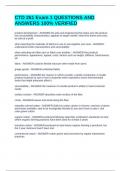CTD 261 Exam 1 QUESTIONS AND
ANSWERS 100% VERIFIED
product development - ANSWER-the jobs and engineering that make sure the product
has serviceability characteristics, appeals to target market, meet time frame and costs,
be sold at a profit
when selecting the materials of fabrics to use or use together you must - ANSWER-
understand textile characteristics and serviceability
when selecting one fiber yarn or fabric over another: - ANSWER-the products
performance, appearance, appeal, costs, factors such as weight, stiffness, hand texture,
etc
fabric - ANSWER-a planar flexible structure often made from yarns
greige goods - ANSWER-unfinished fabric
performance - ANSWER-the manner in which a textile, a textile component, or textile
product responds to use or how it responds when exposed to some environmental
factor that might adversely affect it
serviceability - ANSWER-the measure of a textile product's ability to meet consumer
needs
surface contour - ANSWER-describes outer surface of the fiber
crimp - ANSWER-waves and twists along the fiber
naturally colored cotton - ANSWER-Sally fox cotton, grown in Arizona. versions of green
and brown available. said to be ecologically friendly bc you don't have to dye it. aka
color grown cotton
organic cotton - ANSWER-produced following state fiber certification standards on land
where organic farming practices have been used for at least 3 years
transition cotton - ANSWER-produced on land where organic farming is practiced, but
the 3 year minimum hasn't been met
conventional cotton - ANSWER-cotton grown and processes by regular mainstream
practices
, needs - ANSWER-aesthetic, durability, comfort, safety, appearance, care,
environmental impact, cost
confinement - ANSWER-only one firm can use a color pattern or fabric
assortment - ANSWER-refers to a group of fabric that share a commonality of design
structure and color
tenacity - ANSWER-ability to withstand a heavy pulling force
cross-section - ANSWER-fiber shape affects luster, bulk, body, texture, hand, etc.
green cotton - ANSWER-cotton fabric that has been washed with mild natural-based
soap, but it hasn't been bleached or treated with other chemicals except possibly natural
dyes
cotton - cross section, material, chemical make up - ANSWER-lima bean, cellulose,
hydroxyl group
flax - cross section, material, chemical make up - ANSWER-polygonal, cellulose, lignin
jute - material - ANSWER-cellulose
wool - cross section, material, chemical makeup - ANSWER-round, keratin, disulfide
links
silk - cross section, material, chemical makeup - ANSWER-rounded triangle, Fibroin,
sericin
regain - ANSWER-the percentage of moisture a bone-dry fiber will absorb from the air
under standard conditions of temperature and moisture
how are fibers categorized - ANSWER-natural and manufactured
natural - cellulosic, protein, and mineral
manufactured - cellulosic, protein, synthetic fibers, and mineral
how are natural fibers graded for quality - ANSWER-color of fibers and the absense of
dirt, leaf matter, seed particles, tangles, mote or dead fiber, 39 grades
what key characteristics help to distinguish a fiber from others - ANSWER-cross
section, surface contour, material/polymer source, production method (man made),
notable chemical components
where are fibers produced - ANSWER-China. Spain, france, south korea, austrailia,
new zealand, asia, india, africa, central america, pakistan, bangladash




